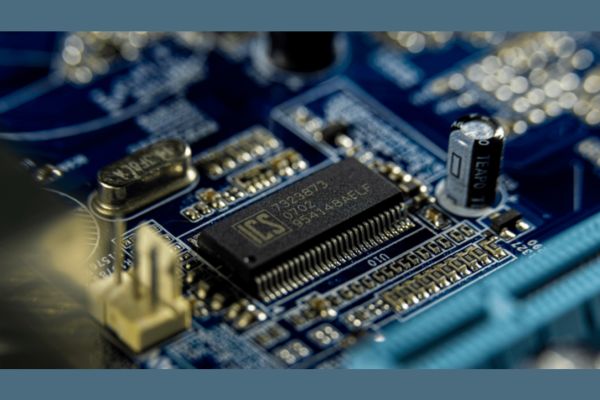The global wide-bandgap semiconductors market is entering a phase of exponential growth, projected to leap from USD 2.13 billion in 2024 to over USD 8.42 billion by 2034, expanding at a robust compound annual growth rate (CAGR) of 14.74%. This surge is driven by the demand for high-efficiency, high-temperature, and high-voltage applications across electric vehicles (EVs), smart grids, renewable energy systems, 5G telecom networks, aerospace, and defense.
Unlike conventional silicon-based chips, wide-bandgap semiconductors, particularly silicon carbide (SiC) and gallium nitride (GaN), offer superior energy efficiency, speed, and thermal resilience. These advantages are translating into real-world benefits like smaller battery sizes, faster charging, and greater energy savings, making them indispensable in modern power electronics.
Wide Band Gap Semiconductors Market Key Insights
- The global WBG semiconductors market was valued at USD 2.13 billion in 2024.
- The market is projected to reach USD 8.42 billion by 2034.
- It is expected to grow at a CAGR of 14.74% from 2025 to 2034.
- Asia Pacific dominated the market with a 46% share in 2024.
- North America is anticipated to register the fastest CAGR during the forecast period.
- Silicon carbide (SiC) led the material segment with a 58% share in 2024.
- Gallium nitride (GaN) is projected to grow at a notable CAGR from 2025 to 2034.
- Power devices accounted for the largest device type share at 52% in 2024.
- RF devices are expected to grow at a significant CAGR during the forecast period.
- The 6-inch wafer segment held the highest share at 38% in 2024.
- The 8-inch wafer category is set to experience the fastest growth through 2034.
- Power electronics led applications with a 41% share in 2024.
- The EVs and charging infrastructure segment is poised for notable growth through 2034.
- Automotive remained the top end-use industry with a 36% share in 2024.
- The telecommunications sector is expected to expand at a noteworthy CAGR during the forecast period.
Why Asia Pacific Leads the Wide Band Gap Semiconductors Market
The Asia Pacific wide band gap (WBG) semiconductors market size was at USD 0.98 billion in 2024 and is predicted to reach around USD 3.92 billion by 2034, at a CAGR of 14.87% from 2025 to 2034.
Asia Pacific leads the global Wide Band Gap (WBG) semiconductors market due to its unique combination of high-volume application industries, advanced manufacturing capabilities, and proactive government support. The region is home to the world’s most dynamic electric vehicle (EV) ecosystem, particularly in China, where over 9.4 million EVs were sold in 2023, accounting for more than 60% of global EV sales. This explosive demand has accelerated the integration of WBG technologies like silicon carbide (SiC) and gallium nitride (GaN) in traction inverters, onboard chargers, and power control units. Additionally, countries like Japan and South Korea are rapidly advancing their EV capabilities, with major automakers such as Toyota, Honda, and Hyundai deploying WBG-based components to enhance vehicle range, performance, and energy efficiency.
Wide Band Gap (WBG) Semiconductors Market: China vs. Japan
| Category | China | Japan |
| 2024 Market Size | USD 6.35 Billion | USD 0.80 Billion |
| Projected Size | USD 15.68 Billion by 2032 | USD 2.00 Billion by 2032 |
| CAGR | 16.3% (2025–2032) | 12.3% (2026–2033) |
| Top Applications | EVs, Renewables, 5G, Industrial, Consumer Electronics | EVs, Industrial, Renewables, Defense, High-End Consumer Devices |
| Leading Domestic Companies | Sanan, CR Micro, Silan Micro, StarPower, SICC | ROHM, Mitsubishi Electric, Fuji Electric, Toshiba, Renesas |
| Foreign Players Active | Infineon, STMicro, Wolfspeed, ON Semi, Mitsubishi | Infineon, TI, STMicro, Wolfspeed, Coherent |
| Government Support | National strategy, subsidies, Big Fund, local grants, standards via CASA | METI subsidies, R&D via NEDO, supply chain support, joint ventures |
| Innovation Focus | Scaling SiC wafers, GaN-on-Si, Ga₂O₃ R&D, vertical integration | Ga₂O₃ commercialization, reliability-focused R&D, precision manufacturing |
| Key Regions & Hubs | Shanghai, Shenzhen, Beijing, Wuhan, Chongqing | Kyoto, Kumamoto, Tokyo, Nagoya, Tohoku |
| Challenges | Tech gaps, price wars, talent shortages, reliance on foreign tools | High costs, small domestic EV market, industry fragmentation |
| Opportunities | Large EV/5G market, cost leadership, export potential, raw material control | Premium quality, auto industry strength, next-gen WBG leadership, global partnerships |
What’s Fueling the Shift to Wide-Bandgap Semiconductors?
“Why are industries replacing silicon with SiC and GaN in high-performance electronics?”
The shift is not just about performance, it’s about sustainability, speed, and scale. Here’s what’s propelling this market forward:
- Electric Vehicles (EVs): SiC-based power inverters and chargers offer lighter systems and greater efficiency, extending range and reducing heat.
- 5G Infrastructure & Telecom: GaN devices enable higher frequency operations, essential for power amplifiers in 5G base stations.
- Smart Grids & Renewables: Solar inverters and battery storage solutions are switching to WBG to reduce power losses and improve reliability.
- Industrial Power Supplies: Data centers, robotics, and factory automation systems are adopting WBG for better thermal management and faster switching.
- Defense & Aerospace: High-reliability, compact, and radiation-resistant components are ideal for radar systems, satellites, and military-grade electronics.
Market Challenges: What Could Slow Down Growth?
Despite its momentum, the WBG semiconductor market faces real hurdles:
- High Initial Costs: SiC and GaN wafers are still 3–5x more expensive than silicon due to complex growth processes and lower yields.
- Fabrication Complexity: These materials require specialized equipment and longer processing times, slowing production scale-up.
- Design and Packaging Limitations: Engineers must adapt to different heat dissipation and signal interference behaviors.
- Talent Shortage: A lack of skilled engineers in WBG design and manufacturing is impeding growth, especially in emerging economies.
Segmentation Deep Dive: What’s Driving Growth Across Layers of the WBG Market?
Material Type Analysis
The wide band gap semiconductors market is primarily led by silicon carbide (SiC), which dominated the material segment with 58% market share in 2024. SiC’s ability to operate at higher voltages, frequencies, and temperatures compared to traditional silicon makes it the top choice for EV powertrains, industrial drives, and energy grids. Meanwhile, gallium nitride (GaN) is emerging as the fastest-growing material due to its exceptional performance in high-frequency and RF applications such as 5G base stations and radar systems. Other promising materials like diamond, zinc oxide (ZnO), gallium oxide (Ga₂O₃), and aluminum nitride (AlN) are gaining traction in niche sectors like space electronics, UV optoelectronics, and extreme-environment sensors. Boron nitride (BN) and other advanced materials continue to see experimental deployment in research-grade and defense-related devices.
Device Type Analysis
In 2024, power devices, including diodes, transistors (MOSFETs, IGBTs), and integrated switching components, claimed the lion’s share of the market, contributing to 52% of total revenue. These devices are fundamental to energy conversion systems used in EVs, inverters, and motor drives. RF devices are expected to see the highest CAGR between 2025 and 2034, driven by the rollout of 5G, satellite communication, and radar applications. This category includes RF amplifiers, RF switches, and RF filters, all of which are core to high-frequency transmission and low-latency networks. Additionally, optoelectronic devices like LEDs, laser diodes, and photodetectors continue to see wide adoption in display technology, optical sensors, and medical imaging.
Wafer Size Analysis
Wafer size plays a pivotal role in manufacturing efficiency and cost economics. As of 2024, the 6-inch wafer segment accounted for the highest share at 38%, primarily due to its maturity in existing fabs and suitability for moderate-volume applications like EV inverters and telecom modules. However, the 8-inch wafer category is projected to register the fastest growth rate, signaling a shift toward mass production and greater throughput in high-volume sectors. Larger wafer formats such as 12-inch are still in the early stages of R&D and capital deployment, while 2-inch and 4-inch wafers remain common in niche or legacy product lines. The migration toward larger wafers is also helping reduce per-chip costs, which will support mainstream adoption in consumer applications.
Application Analysis
Among the wide range of applications, power electronics emerged as the clear frontrunner, contributing a 41% market share in 2024. These include industrial drives, renewable energy inverters, UPS systems, and energy-efficient computing infrastructure. Notably, the electric vehicles (EVs) and charging infrastructure segment is poised to grow at a remarkable CAGR between 2025 and 2034, as automakers race toward electrification and global governments enforce stricter emissions standards. Other high-impact applications include RF & microwave systems for 5G and aerospace; lighting and displays driven by automotive LEDs and microLED panels; and consumer electronics such as smartphones, gaming consoles, and wearables. Medical devices and sensors are emerging subcategories benefiting from WBG materials’ miniaturization and low-heat dissipation properties.
End-use Industry Analysis
On the industry vertical side, automotive is the most dominant, representing 36% of the total market in 2024. EVs, onboard chargers, DC-DC converters, and power management modules are pushing SiC and GaN adoption into nearly every new vehicle platform. Industrial applications such as motor controls, robotics, and heavy equipment follow closely, leveraging WBG devices for their reliability and efficiency. Meanwhile, telecommunications is expected to see significant growth through 2034, thanks to the massive deployment of 5G infrastructure, IoT backbones, and cloud-based data centers. Consumer electronics, energy & utility, aerospace & defense, and healthcare round out the market, each finding value in the unique capabilities of WBG technologies, whether it’s ultra-fast charging, high-power RF transmission, or compact medical imaging tools.
Wide Band Gap (WBG) Semiconductors Market Key Players
- Cree LED (subsidiary of Smart Global Holdings)
- Efficient Power Conversion Corporation (EPC)
- GaN Systems (acquired by Infineon)
- Infineon Technologies AG
- IQE plc
- MACOM Technology Solutions
- Microchip Technology Inc.
- Navitas Semiconductor
- Nexperia
- NXP Semiconductors
- ON Semiconductor (onsemi)
- Power Integrations, Inc.
- Qorvo, Inc.
- ROHM Semiconductor
- Skyworks Solutions Inc.
- STMicroelectronics
- Sumitomo Electric Industries, Ltd.
- Texas Instruments Incorporated
- Transphorm Inc.
- Wolfspeed, Inc.

















